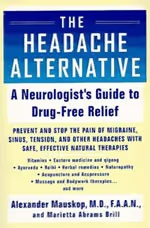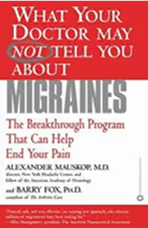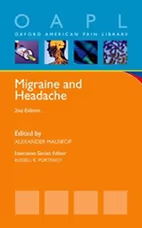Cluster Headache
Cluster headache is perhaps the most painful and severe type of headache. The term “cluster” is used because these headaches come in clusters, occurring for weeks to months at a time, then disappearing suddenly and completely for months or years. Many people also report that the clusters occur with striking regularity in a cyclical daily or seasonal pattern. Cluster headaches are often mistaken for sinus or migraine headaches. Cluster headache is present in less than one percent of the population. It is more commonly seen in men. These headaches can begin at any age, but usually occur between the ages of 20 and 40 years. Cluster headaches are not life-threatening and do not cause any permanent damage to the brain. However they can be quite debilitating and interfere with work and enjoyment of life. In a small number of cluster headache sufferers headaches continue for more than a few months, sometimes for years. These are called chronic cluster headaches.
Cluster headache attacks often occur at night, waking the person from sleep. The pain is usually described as sharp, stabbing, or burning, like a “hot poker in the eye.”
Characteristic features include the following:
Severe, one-sided pain in or around the eye, temple, forehead or cheek areas
Individual attacks lasting 15 minutes to 3 hours.
Begins suddenly and peaks quickly (within minutes)
Can occur from every other day to 8 times a day
Sense of agitation or restlessness during the headache
Often triggered by alcohol
Accompanied by at least one of these “autonomic features” on the same side as the head pain:
Tearing
Redness of the eye
Dilated pupil
Droopy eyelid
Stuffed nostril
Runny nose
Forehead or facial sweating
The cause of cluster headaches is not fully understood. Since the headaches are characterized by pain, autonomic features, and a regular cyclical pattern, several parts of the brain are probably involved. The pain itself is likely to be related to the activation of the trigeminal nerve deep in the brain, which has connections to the layers of tissue covering the brain as well as the blood vessels. Stimulation of this nerve results in inflammation, which results in pain. However, the underlying cause of cluster headache is much more complex. The hypothalamus, which regulates the body’s biological clock, has been proposed as the activation center for cluster headache given the striking clockwork-like pattern of attacks seen in most patients. Genetics may also play a role since many patients with cluster headaches have family members who have cluster or migraine headaches. Further studies are needed to fully clarify the cause of cluster headaches.
Both acute and preventative medications are used in the treatment of cluster headache. Acute treatment includes oxygen inhalation, triptans (such as Imitrex injections and Zomig nasal spray) or ergotamines. Preventative medications are taken on a daily basis as prophylaxis against cluster attacks. These include blood pressure medications (high doses of verapamil), anti-epilepsy drugs (Depakote, Topamax), Lithium, and other. In a small number of cases, an herbal product Boswellia has been reported to help cluster headaches. Several of my patients with chronic cluster headaches responded very well to Botox injections. Botox is approved for chronic migraines but not cluster headaches, which may complicate efforts to get insurance companies to pay for it. Magnesium infusions, which can be given in the office, are also helpful in treating cluster headaches. In many cases, a short course of a steroid medication, such as prednisone can quickly stop the headache cycle.
.jpg)



This “book” appears to have largely been born out of his blog from the New York Headache Center. For years, he has regularly put up information, scientific and clinical, for his headache followers. He has created this “book,” actually an e-book, which takes relevant information from his experience and knowledge of migraine. There is no need for an index and chapter references. He uses hyperlinks, embedded in the e-book, to connect to material online, which he puts in context for the reader. This works very well as one hyperlink may go to an original paper or publication or a resource site.
He links to major medical journals including headache journals and his own publications, when helpful, as well as nonmedical literature and other sites. This format allows the e-book to be updated from time to time, which is easy to do with this approach.
The book has a very interesting introduction and deals with evidence-based medicine and its role in migraine therapy. When he begins the section on 150+ treatments, he starts with a very interesting comment. Many of the treatment ideas that I describe in this book are not just off-label (that is, not approved by the FDA) but may appear to be off-the-wall. It is refreshing to hear such intellectual honesty from a practicing neurologist.
There is a great section on supplements and finding someone to help with your migraine, such as coach, a partner, or a sympathetic friend. A diagnostic discussion follows and is most helpful, as proper diagnosis directs treatment, as are the detailed sections on triggers including environment, food, exercise, physical therapies, and sleep. Herbal therapies are covered as is neuromodulation and injections/blocks among others.
In the sections on drugs, he deals with acute therapies and the modern use of triptans and gepants, and a ditan. Preventive therapies start with monoclonal calcitonin gene-related peptide antibodies, tricyclic medications, and many other preventive therapies including beta blockers, anti-seizure drugs, nonsteroidal anti-inflammatory drugs, and botulinum injections. From acupuncture to Feldenkrais methods, he covers the contemporary plethora of migraine “treatments” as he sees it in practice.
He ranks all medications on a 1 to 10 scale regarding his own subjective opinions of the utility of each treatment. He indicates that no treatment gets 10 as a score and any receiving a score of 1 were not rated. He also lists his favorite migraine therapies separately. He includes a lot of data links here, from single case reports to full-scale randomized clinical trials, and detailed reviews. His clinical acumen shines through the volume and one gets the impression that this is a very personal view at times, not always backed by evidence, as there may not be any, but by experience, practice and pragmatism. He carefully notes the general things to be careful of in taking some treatments and warns if there are serious concerns. Nonetheless, he indicates clearly that the advice of a medical professional should be sought before trying the therapies mentioned.
Diagnosing secondary headache that can mimic migraine or vice versa is a useful section but does not go into depth about the disorders/diseases mentioned, as this is not the intention of the book. Special circumstances are given sections including menstrual migraine, pregnancy, resistant/refractory headache, aura and headache, and many others.
The author is a senior, highly experienced neurologist and has a high degree of interest in migraine and other headache disorders. He has a sense of curiosity about the brain and migraine and that comes through to the reader of this small volume. I count 23 endorsements, including the excellent foreward of the book from a wide range of well-known people, which includes two prior editors of this journal. He is well liked and highly respected by his colleagues.
In many ways, this book does what online databases on diseases cannot do most times. He tells the reader what he knows and how to use that knowledge. He directs the novice and experts to the right literature and takes the reader on a personal journey through the field of migraine treatments. He tells people, “…keep seeking relief, not to give up on or blame yourself for the pain you experience from migraine.”
There is a printed version of the book; however, the e-book is ideal for the intended purpose. I would recommend it the first instance. It is available via a commercial site and inexpensive.
I would recommend this book to anyone who has migraine or cares for people with migraine and wants a broad and sometimes detailed overview of the treatments. Available in the e-book format, it represents a lot of work for one person, but his passion, occasional humor, and historical perspectives are evident in this work. You don’t have to agree or accept everything the author says to enjoy and benefit from this “book,” and I know he would want people to be critical and skeptical where warranted. However, you will find more than you would usually need to know from this banquet of 150 ways to help your migraines! Enjoy, I did very much. Read it through once and save as reference.
Alexander Mauskop, Director of the New York Headache Center, and Marietta Abrams Brill, a freelance medical writer, have written principally for headache sufferers in North America. They answer questions like “is Rolfing covered by medical insurance?”, and include an excellent resource section in the back. of the book which lists American organizations for the various therapies. But they provide enough background information on both headache and alternative treatments to make their book interesting to readers from other countries, too. In covering most of the more common alternative therapies~like herbs, acupuncture, massage, Ayuverda and Eastern medicine, and qigong-they aim to inform rather than judge, cite research evidence where it exists, and point to potential dangers as well as benefits.
Each of the 10 chapters is introduced with a pithy quote: “Divine is the work to subdue pain” (Hippocrates) heads the first chapter. After general background on pain theories and headache diagnosis, common alternative approaches are covered in turn and there is, of course, oodles of advice on diet and nutrition. A helpful glossary guides readers through words that conventional doctors are familiar with, like Scotoma, and those with which we aren’t, like Qi, Vatta, and Pitta. To round off, a comprehensive resource section and selected bibliography give useful directions to readers wanting more information about specific therapies.
Like all good guides, this one follows a logical structure and so it is relatively simple to go quickly to the information you want to find. It is easy to read. All in all, it is a guide which headache sufferers looking for good information on alternative therapies can be thankful for.
